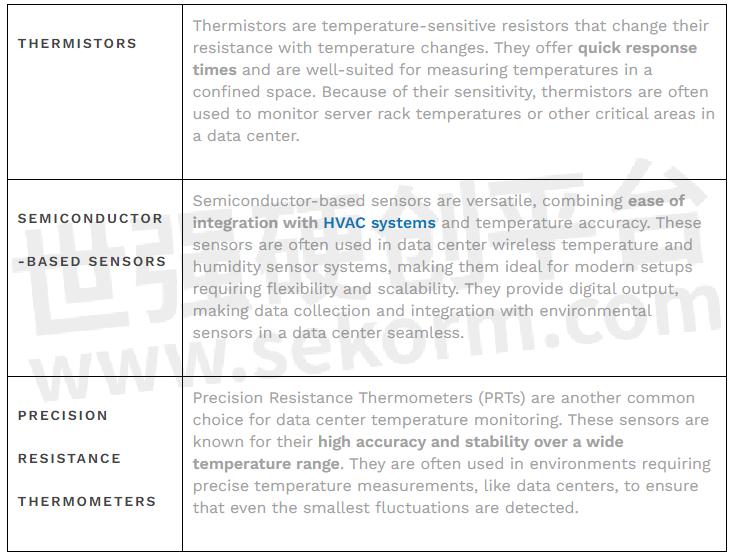Keeping Cool with Data Center Temperature Sensors

The internet runs on data centers.
These massive warehouses are home to the servers and equipment that power everything from online shopping to social media platforms to global financial transactions. But keeping all that processing power humming smoothly comes at a cost — a thermal cost, to be precise.
Data centers are notorious for generating a lot of heat. This heat can have a detrimental effect on the sensitive electronics comprising each center. Just like pushing a car engine too hard can cause it to overheat and crash, excessive heat within a data center can lead to equipment failures, costly downtime, and even data loss.
This is where data center temperature sensors come into play. With the right sensors in place, facility managers can protect sensitive equipment from extreme temperatures, ensure optimal performance, and reduce energy costs.
The High Cost of High (or Low) Temperatures
Think of a data center as a high-performance athlete. Just as intense exertion generates heat, the processing power of servers creates thermal energy. If this heat isn't efficiently managed, it can have disastrous consequences.
Reduced Equipment Lifespan: When temperatures consistently exceed recommended ranges, server components degrade faster, leading to more frequent hardware failures and costly replacements.
Increased Downtime: Overheating can trigger automatic shutdowns to prevent permanent damage. This translates to downtime for critical applications and lost revenue for businesses.
Energy Waste: Overly aggressive cooling systems consume unnecessary power to maintain excessively low temperatures.
Conversely, ambient conditions on the other side of the thermostat can lead to condensation forming on sensitive electronics. This moisture can cause electrical shorts and corrosion, resulting in equipment damage and downtime. Furthermore, low temperatures can lead to less efficient cooling processes, potentially negating energy-saving efforts.
So, how do you strike the perfect balance between keeping things cool and being energy efficient?
Enter data center temperature sensors.
Understanding Data Center Temperature Sensors
Data center temperature sensors are the eyes and ears of your climate control system. These tiny devices provide real-time data on temperature and some insight into potential humidity levels throughout your facility. They come in various forms, each suited to different applications:

Choosing the Right Temperature Sensor for A Data Center Depends on Various Factors, Including:
Precision
Data centers often require precise temperature control within a narrow range to maintain optimal operating conditions for servers and other equipment. A sensor with a high degree of precision is essential to accurately monitoring and regulating temperature levels.
Response Time
A sensor with a fast response time is crucial for quickly detecting temperature fluctuations and initiating appropriate adjustments. This is particularly important in preventing overheating or undercooling, which can lead to equipment failures or performance degradation.
Compatibility
Ensuring compatibility with existing systems is another critical factor. Older HVAC systems may have specific requirements or limitations to consider when selecting a sensor. Compatibility issues can arise in communication protocols, power requirements, or physical mounting options.
Design Considerations for Temperature Sensor Systems
While selecting the appropriate sensor is crucial in any industrial application, how temperature sensors are deployed within a data center is equally important. Poor sensor placement can result in incomplete or inaccurate temperature readings, leading to inefficient climate control and potential equipment failures.
Here are four things to consider when designing a temperature sensor system:
1. Sensor Placement
Temperature sensors should be strategically placed throughout the data center to provide comprehensive coverage. The ideal locations often include:

2. Size of the Space and Dead Air Spaces
The size and design of a data center play a role in determining the number of sensors required and where they should be placed. Larger facilities may need multiple sensors at strategic locations to ensure consistent temperature monitoring throughout. Additionally, identifying and monitoring dead air spaces — areas where airflow is restricted — can prevent hot spots from developing. Installing temperature sensors in these areas allows facility managers to adjust the airflow and maintain a stable climate across the entire facility.
3. Sensor Accuracy and Reliability
The accuracy and reliability of a data center temperature sensor system are vital for effective environmental monitoring. The best sensors provide precise temperature readings, often within a fraction of a degree. This level of accuracy is critical as even small temperature fluctuations can seriously affect sensitive data center equipment.
Data centers run 24/7, so the sensors must be able to perform consistently without fail. By choosing advanced, high-quality sensors with proven track records, data centers can minimize the risk of sensor failure and ensure continuous, accurate monitoring.
While calibration is crucial to maintaining many types of technology, advanced sensors often eliminate the need for this process. These sensors are designed to provide high accuracy and precision from the start, reducing the likelihood of calibration issues. Investing in advanced sensor technology can simplify maintenance routines and ensure reliable performance.
4. Integration with the HVAC System
Most data center HVAC systems use feedback mechanisms to maintain ideal temperatures, adjusting airflow and cooling based on sensor readings. This allows for precision temperature control while optimizing energy usage. Data center wireless temperature sensors can streamline integration with HVAC systems by offering flexible placement options and reducing the need for wired connections.
Effective integration of environmental sensors in the data center also helps prevent dead air spaces, where airflow is insufficient to regulate temperatures. Monitoring these spaces with sensors ensures even temperature distribution, eliminating hotspots that could compromise equipment.
Sourcing Advanced Temperature Sensors from Manufacturers
To source advanced temperature sensors for your data center, consider reaching out directly to manufacturers. These experts offer tailored solutions, high-quality products, and direct support, ensuring optimal performance and reliability in your critical infrastructure.

Data Center Temperature Sensors: Investing in Uptime
Data center temperature sensors are more than just hardware; they are indispensable tools for maintaining a stable and efficient operating environment.
By accurately monitoring temperatures and providing real-time data, these sensors enable precise HVAC control, preventing equipment failures, minimizing downtime, and protecting valuable data. By investing in a robust temperature sensor system, data center operators can ensure the longevity and reliability of their critical infrastructure, ultimately safeguarding uptime.
Need help with implementing sensors or upgrading your system?
- +1 Like
- Add to Favorites
Recommend
- Temperature Characteristics of Current Fuses
- Find Your Solutions from Wide Lineup of Temperature Sensors for Industrial Machinery— Slim, Compact Temperature Sensors for Motors
- The Application of Socay NTC Thermistors in The Field of Temperature Measurement, The Temperature Measurement Range of Thermistors Can Reach -40 ℃ to +125 ℃
- Fast Response Times and Accurate Readings Temperature Sensors‘ Important Role in Critical Care
- LoRaCC68 Series Wireless Transceiver Modules with a Sensitivity of -129dBm and an Output Power of 22dBm, Achieve Temperature Control in Thermostats
- In 2022, Melexis’ Outperforming Product Lines Were Current Sensors, Embedded Drivers, Magnetic Position Sensors, and Temperature Sensors
- NOVOSENSE NST1002 Temperature Sensor Facilitates Accurate CGM Measurement with Glucose Monitoring Black Technology
- SEMITEC‘s Smaller,Lighter Temperature Sensors for Diverse Mobile Devices
This document is provided by Sekorm Platform for VIP exclusive service. The copyright is owned by Sekorm. Without authorization, any medias, websites or individual are not allowed to reprint. When authorizing the reprint, the link of www.sekorm.com must be indicated.






























































































































































































































































































































































































































































































































































































































































































































































































































































































